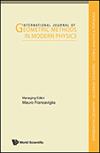Cosmography for Various Parametrizations of Dark Energy Equation of State
IF 2.2
3区 物理与天体物理
Q2 PHYSICS, MATHEMATICAL
International Journal of Geometric Methods in Modern Physics
Pub Date : 2023-11-04
DOI:10.1142/s0219887824500518
引用次数: 1
Abstract
The concept of dark energy (DE) emerged as a result of confirming the accelerated expansion of the universe. Since then, numerous models have been developed to explore the origin and nature of DE. In this study, we investigate several recent cosmological models (Models 1–9) based on the parametrization of the DE equation of state. Our analysis focuses on a homogeneous, isotropic flat universe comprising DE, dark matter (DM), and radiation. We assume the separate conservation of the dark components (DE and DM) and radiation. By employing various parametrizations of [Formula: see text], we derive the corresponding Hubble function [Formula: see text]. To understand the cosmic expansion history of the universe in a model-independent manner, we employ cosmography as an approach. We express important cosmographic parameters such as deceleration, jerk, snap, and lerk parameters in terms of the Hubble rate [Formula: see text] and its derivative up to the fourth order. Additionally, we examine the statefinder parameter and [Formula: see text] diagnostics to distinguish between different types of DE models. Finally, we compare the physical interpretations of these diagnostic parameters with the standard [Formula: see text]CDM model to assess the viability of each model.暗能量状态方程各种参数化的宇宙学
暗能量(DE)的概念是在确认宇宙加速膨胀的结果中出现的。从那时起,人们开发了许多模型来探索DE的起源和本质。在本研究中,我们研究了基于DE状态方程参数化的几种最新宇宙学模型(模型1-9)。我们的分析集中在一个均匀的,各向同性的平坦宇宙,包括暗物质(DM)和辐射。我们假设暗成分(DE和DM)和辐射的单独守恒。通过对[公式:见文]的各种参数化,我们推导出相应的哈勃函数[公式:见文]。为了以独立于模型的方式理解宇宙的宇宙膨胀历史,我们采用宇宙学作为一种方法。我们用哈勃速率(公式:见文本)及其四阶导数来表示重要的宇宙学参数,如减速、急转、急转和勒克参数。此外,我们检查了状态查找器参数和[公式:见文本]诊断,以区分不同类型的DE模型。最后,我们将这些诊断参数的物理解释与标准[公式:见文本]CDM模型进行比较,以评估每个模型的可行性。
本文章由计算机程序翻译,如有差异,请以英文原文为准。
求助全文
约1分钟内获得全文
求助全文
来源期刊
CiteScore
3.40
自引率
22.20%
发文量
274
审稿时长
6 months
期刊介绍:
This journal publishes short communications, research and review articles devoted to all applications of geometric methods (including commutative and non-commutative Differential Geometry, Riemannian Geometry, Finsler Geometry, Complex Geometry, Lie Groups and Lie Algebras, Bundle Theory, Homology an Cohomology, Algebraic Geometry, Global Analysis, Category Theory, Operator Algebra and Topology) in all fields of Mathematical and Theoretical Physics, including in particular: Classical Mechanics (Lagrangian, Hamiltonian, Poisson formulations); Quantum Mechanics (also semi-classical approximations); Hamiltonian Systems of ODE''s and PDE''s and Integrability; Variational Structures of Physics and Conservation Laws; Thermodynamics of Systems and Continua (also Quantum Thermodynamics and Statistical Physics); General Relativity and other Geometric Theories of Gravitation; geometric models for Particle Physics; Supergravity and Supersymmetric Field Theories; Classical and Quantum Field Theory (also quantization over curved backgrounds); Gauge Theories; Topological Field Theories; Strings, Branes and Extended Objects Theory; Holography; Quantum Gravity, Loop Quantum Gravity and Quantum Cosmology; applications of Quantum Groups; Quantum Computation; Control Theory; Geometry of Chaos.

 求助内容:
求助内容: 应助结果提醒方式:
应助结果提醒方式:


